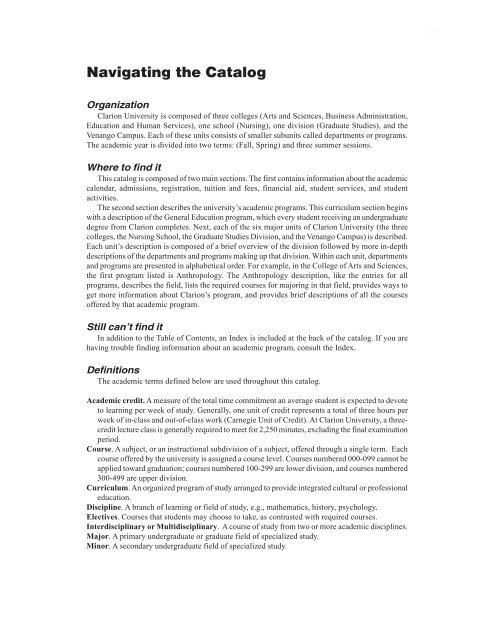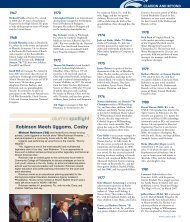Undergraduate - Clarion University
Undergraduate - Clarion University
Undergraduate - Clarion University
You also want an ePaper? Increase the reach of your titles
YUMPU automatically turns print PDFs into web optimized ePapers that Google loves.
Navigating the Catalog<br />
Organization<br />
<strong>Clarion</strong> <strong>University</strong> is composed of three colleges (Arts and Sciences, Business Administration,<br />
Education and Human Services), one school (Nursing), one division (Graduate Studies), and the<br />
Venango Campus. Each of these units consists of smaller subunits called departments or programs.<br />
The academic year is divided into two terms: (Fall, Spring) and three summer sessions.<br />
Where to find it<br />
This catalog is composed of two main sections. The first contains information about the academic<br />
calendar, admissions, registration, tuition and fees, financial aid, student services, and student<br />
activities.<br />
The second section describes the university’s academic programs. This curriculum section begins<br />
with a description of the General Education program, which every student receiving an undergraduate<br />
degree from <strong>Clarion</strong> completes. Next, each of the six major units of <strong>Clarion</strong> <strong>University</strong> (the three<br />
colleges, the Nursing School, the Graduate Studies Division, and the Venango Campus) is described.<br />
Each unit’s description is composed of a brief overview of the division followed by more in-depth<br />
descriptions of the departments and programs making up that division. Within each unit, departments<br />
and programs are presented in alphabetical order. For example, in the College of Arts and Sciences,<br />
the first program listed is Anthropology. The Anthropology description, like the entries for all<br />
programs, describes the field, lists the required courses for majoring in that field, provides ways to<br />
get more information about <strong>Clarion</strong>’s program, and provides brief descriptions of all the courses<br />
offered by that academic program.<br />
Still can’t find it<br />
In addition to the Table of Contents, an Index is included at the back of the catalog. If you are<br />
having trouble finding information about an academic program, consult the Index.<br />
Definitions<br />
The academic terms defined below are used throughout this catalog.<br />
Academic credit. A measure of the total time commitment an average student is expected to devote<br />
to learning per week of study. Generally, one unit of credit represents a total of three hours per<br />
week of in-class and out-of-class work (Carnegie Unit of Credit). At <strong>Clarion</strong> <strong>University</strong>, a threecredit<br />
lecture class is generally required to meet for 2,250 minutes, excluding the final examination<br />
period.<br />
Course. A subject, or an instructional subdivision of a subject, offered through a single term. Each<br />
course offered by the university is assigned a course level. Courses numbered 000-099 cannot be<br />
applied toward graduation; courses numbered 100-299 are lower division, and courses numbered<br />
300-499 are upper division.<br />
Curriculum. An organized program of study arranged to provide integrated cultural or professional<br />
education.<br />
Discipline. A branch of learning or field of study, e.g., mathematics, history, psychology.<br />
Electives. Courses that students may choose to take, as contrasted with required courses.<br />
Interdisciplinary or Multidisciplinary. A course of study from two or more academic disciplines.<br />
Major. A primary undergraduate or graduate field of specialized study.<br />
Minor. A secondary undergraduate field of specialized study.
















